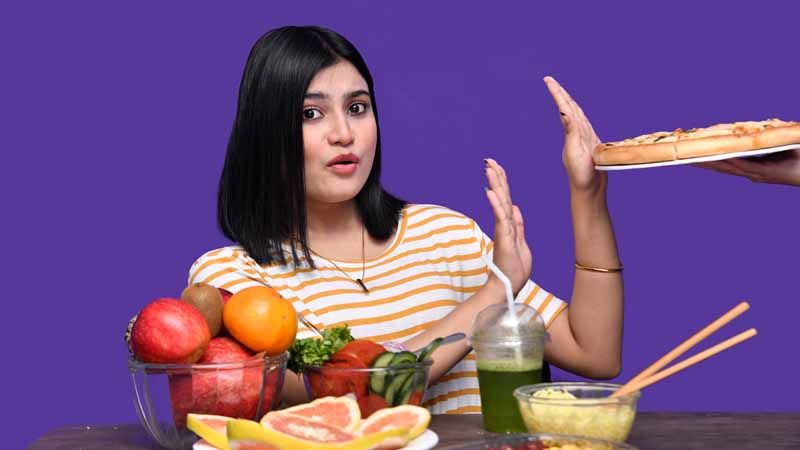Diet For A Healthy Heart: Foods To Eat And Avoid + Meal Chart
- 10 days ago
Key points:
- Sugary foods and refined carbs add up too many empty calories that provide no nutritional value and are bad for your heart.
- Focus on high-fiber diet and foods rich in MUFA (mono unsaturated fatty acids)
- Make healthy tweaks in your diet like controlling portion size and having frequent meals.
The saying “you are what you eat” is becoming more relevant with every passing year in India. According to the Global Burden of Disease, "Nearly a quarter (24.8 per cent) of all deaths in India is due to CVDs". There is a drastic increase in the number of people with coronary artery disease and the decreasing age at which people are falling prey to killer diseases like heart attack.
Risk factors for a heart disease:
- Non-modifiable risks - Age, gender, race and heredity
- Modifiable risk factors- Excess weight, abdominal obesity, high LDL cholesterol, high triglycerides, high blood pressure, low HDL cholesterol, diabetes, stress, and substance abuse.
Role of food in keeping heart healthy
Food that we eat can directly affect many of the changeable risk factors. Fortunately, correcting the dietary habits of ‘at risk’ persons, will help control most of the modifiable risk factors. This not only reduces the disease-burden but also the economic burden on the person.

Food that can increase the risk of heart disease
1] Fats and oils
In excess, fats and oils contribute to overweight, abdominal obesity (paunch), high cholesterol, high triglycerides, and diabetes. Saturated fats and Trans fats increase LDL cholesterol (bad cholesterol) levels. Trans fats can also decrease HDL cholesterol (good cholesterol). Fried food and high-fat food are responsible for many of the cardiac risk factors.
2] Non-vegetarian food
Try to avoid non-vegetarian items like fatty beef, lamb, pork, poultry with skin full fat dairy products as they are rich in fats, especially saturated fats. The reason being, your body is unable to process high intake of food cholesterol, and can lead to an imbalance in blood cholesterol levels.
3] Sugars - especially refined sugar and sodium - in excess
Sweets and desserts are among the major causes of excess weight and high triglycerides. Foods that are high in added sodium (salt, MSG, baking soda) increase the chances of hypertension, particularly in salt-sensitive persons.
4] Caffeine
Though there’s no conclusive evidence on caffeine’s effect on heart disease, large amounts of caffeine might increase blood pressure and harm heart.
5] Alcohol
Excess alcohol consumption can increase triglycerides and blood pressure. Additionally, heavy drinking can lead to serious health problems like liver disease, cancer, and peptic ulcers.
Also read: Lower cholesterol for heart health
Food that can prevent heart disease
1] Fruits and vegetables with fiber, antioxidants and micronutrients
Fiber rich foods have a tremendous preventive and therapeutic effect on coronary artery disease.
2] Foods rich in MUFA (mono unsaturated fatty acids)
Almonds, hazelnuts, cashew, olives, peanuts, sesame seeds, avocado, sun flower seeds, nut and seed butters are rich sources of Omega 3 fats and mono unsaturated fatty acids. Additionally, oily fish (salmon, mackerel etc.) flaxseed and walnuts fall in the same category and have been found to be heart friendly.
Related read: Eating nuts for heart health
3] Whole grains, beans and lentils
Lentils are a rich source of fiber, folic acid, & potassium. These are vital nutrients that support heart health. Whole grains (also contain B vitamins) and beans may help reduce “bad” LDL cholesterol and minimize the chances of heart disease.
Sample diet plan to boost heart health
A heart-healthy diet may reduce your risk of heart disease or stroke by 80%. It is recommended that you consult a dietitian before adhering to any meal chart so as to avoid any risks related to food choices or related allergies.
|
Meal |
Menu |
Quantity |
|
Early Morning |
Tomato juice / Cinnamon water + Almonds + Walnuts |
1 Glass 5 No. 2 No. |
|
Breakfast |
Quinoa upma / Vegetable daliya / Ragi idli / Egg white omelet + Milk |
1 Bowl / 1 Serving 1 Glass |
|
Mid-Morning Snack |
Whole fruit |
1 Whole |
|
Lunch |
Salad + Seasonal vegetable + Lentil / Beans curry + Vegetable raita + Multigrain roti |
1 Bowl 1 Bowl 1 Bowl 1 Bowl 2 No. |
|
Mid-Evening Snack |
Coconut water / Lemon water + Roasted grains |
1 Glass Handful |
|
Dinner |
Salad / Vegetable soup + Seasonal vegetable + Lentil curry + Bran Roti |
1 Bowl 1 Bowl 1 Bowl 2 No. |
|
Post Dinner |
Milk |
1 Glass |
Additional tips:
1] Cook your own food
Cooking food by yourself will allow you to analyze what is going inside your body. How likely it is that you'll pour half jar of mayonnaise in your sandwich? Of course not, rather you'll use the ingredients cautiously.
2] Include green tea in your routine
Green tea is a great beverage that can help to speed up your metabolism. You can either stick to the original taste or try flavored ones.
3] Control portion size and manage weight
Excess weight often leads to high blood pressure—a major cause of heart disease. Reducing portion sizes is a pivotal step toward losing or maintaining a healthy weight. Example-
#1. 1 cup cooked pasta or rice
Serving Size: 2 starch
Reference Size: Tennis ball
#2. 1/2 cup cooked vegetables or fruit
Serving Size: 1 vegetable or fruit
Reference Size: Baseball
4] Do not skip meals - Eat frequently
Skipping meals doesn't help at all. It drops the metabolism and deprives you of key nutrients. Have frequent meals and healthy snacks to promote weight loss and consume important nutrients throughout. Split up your calories into 4 to 6 smaller meals throughout the day.
5] Replace processed food with healthy substitutes
Instead of consuming sugary soft drinks, white bread, pasta and processed foods like pizza, go for unrefined whole grains like whole wheat or multigrain bread, brown rice, barley, quinoa, bran cereal, oatmeal.








